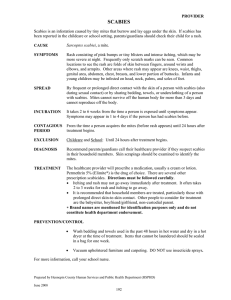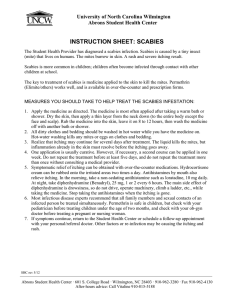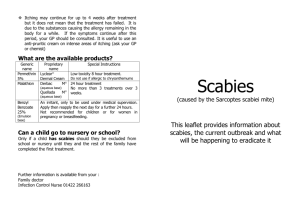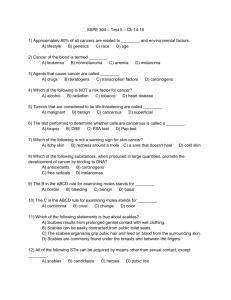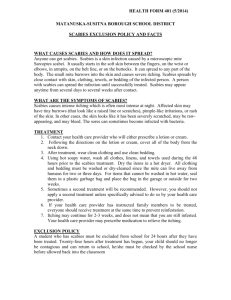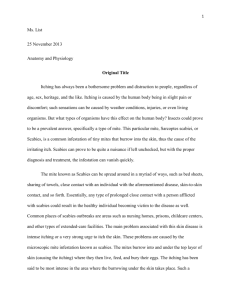Scabies: Prevention and treatment
advertisement
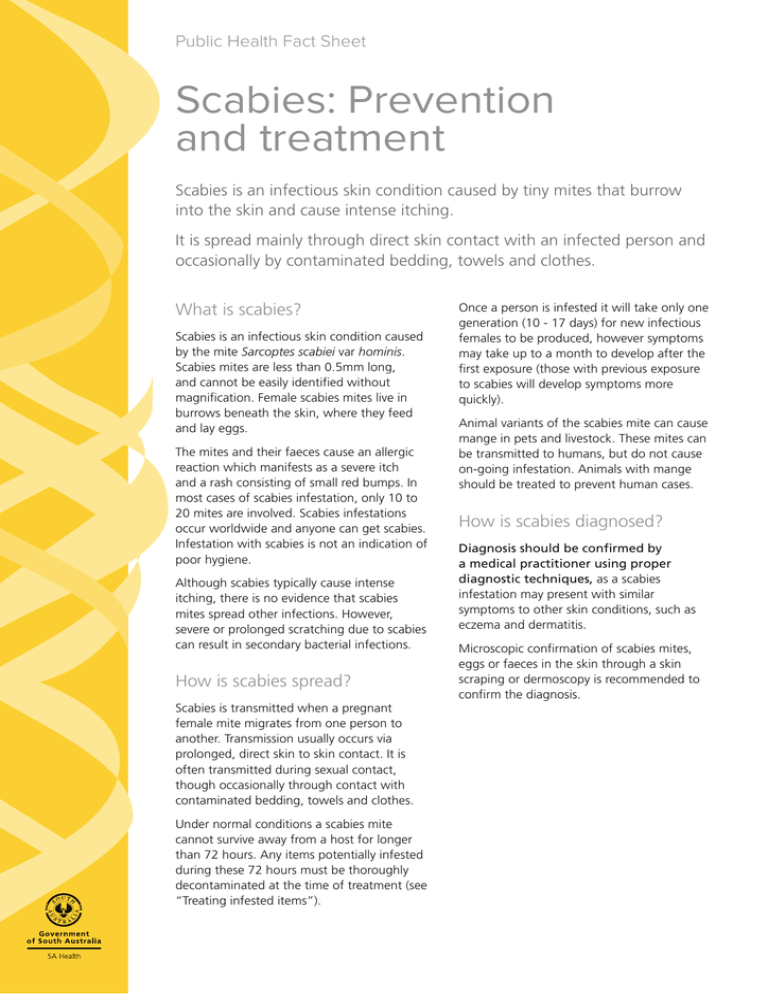
Public Health Fact Sheet Scabies: Prevention and treatment Scabies is an infectious skin condition caused by tiny mites that burrow into the skin and cause intense itching. It is spread mainly through direct skin contact with an infected person and occasionally by contaminated bedding, towels and clothes. What is scabies? Scabies is an infectious skin condition caused by the mite Sarcoptes scabiei var hominis. Scabies mites are less than 0.5mm long, and cannot be easily identified without magnification. Female scabies mites live in burrows beneath the skin, where they feed and lay eggs. The mites and their faeces cause an allergic reaction which manifests as a severe itch and a rash consisting of small red bumps. In most cases of scabies infestation, only 10 to 20 mites are involved. Scabies infestations occur worldwide and anyone can get scabies. Infestation with scabies is not an indication of poor hygiene. Although scabies typically cause intense itching, there is no evidence that scabies mites spread other infections. However, severe or prolonged scratching due to scabies can result in secondary bacterial infections. How is scabies spread? Once a person is infested it will take only one generation (10 - 17 days) for new infectious females to be produced, however symptoms may take up to a month to develop after the first exposure (those with previous exposure to scabies will develop symptoms more quickly). Animal variants of the scabies mite can cause mange in pets and livestock. These mites can be transmitted to humans, but do not cause on-going infestation. Animals with mange should be treated to prevent human cases. How is scabies diagnosed? Diagnosis should be confirmed by a medical practitioner using proper diagnostic techniques, as a scabies infestation may present with similar symptoms to other skin conditions, such as eczema and dermatitis. Microscopic confirmation of scabies mites, eggs or faeces in the skin through a skin scraping or dermoscopy is recommended to confirm the diagnosis. Scabies is transmitted when a pregnant female mite migrates from one person to another. Transmission usually occurs via prolonged, direct skin to skin contact. It is often transmitted during sexual contact, though occasionally through contact with contaminated bedding, towels and clothes. Under normal conditions a scabies mite cannot survive away from a host for longer than 72 hours. Any items potentially infested during these 72 hours must be thoroughly decontaminated at the time of treatment (see “Treating infested items”). page 17 Scabies: Prevention and treatment Treating infested items Scabies can be transmitted to people through infested items (fomites) the infested person has been in contact with, necessitating the disinfestation of personal effects, clothing, linen and mattresses. Fomites should be treated in conjunction with each application of topical scabicide. Fomites are generally treated with heat (such as a hot wash) or isolated for 72 hours to kill mites. It is recommended that clothing and linen that have been used within the last 72 hours are washed on a hot wash (>50°C) or tumble dried. Items which can not be washed (fragile or personal effects) should be sealed in bags and left for 72 hours. Mattresses should be steam cleaned or ironed. Insecticides are generally not needed. Treatment Once diagnosed, most scabies infestations are easily treated. Your doctor will prescribe a cream or lotion that should be applied to all skin from the neck down and left on for at least eight hours (depending on the treatment) to kill the mites burrowed beneath the skin. Topical permethrin cream (5%) is the first line treatment for typical scabies. Always follow the directions on the product label. It is important to discuss treatment options with your doctor before treating infants, pregnant or breastfeeding women, the elderly, or those with pre-existing skin conditions. When applying topical scabies treatments it is extremely important that treatment is thorough. Lack of coverage is the primary reason for treatment failures. All close family, friends and sexual contacts must be treated at the same time (regardless of whether they show symptoms) to prevent further spread or reinfestation. Environmental disinfection should occur at the same time. Once the infestation has been eliminated, it may take 2-4 weeks for the itch to fully resolve, though some improvement of the rash and itch is usually seen within the first week. If treatment failure or reinfestation is suspected seek medical re-assessment. If a third treatment is required, active infestation with scabies should be confirmed microscopically through a skin scraping or dermoscopy by a medical professional. Failure to: adhere to the label directions, cover skin sufficiently, retreat in seven days, treat contacts and disinfest the environment may result in a treatment failure. As there should be no surviving adult mites upon completion of the first treatment, it is generally fine to return to work/school the day after the first treatment. As current treatments for scabies are not effective against scabie eggs a second treatment will be required in seven days (or as per label direction) to kill mites that have hatched since the first application. For more information Health Protection Programs SA Health Telephone: 08 8226 7100 Fax: 08 8226 7102 Telephone: 08 8226 7100 Email: healthprotectionprograms@health.sa.gov.au www.health.sa.gov.au © Department for Health and Ageing, Government of South Australia. All rights reserved. ISBN: 978-1-74243-339-4 FIS: 12110.2-1 Printed July 2012. www.ausgoal.gov.au/creative-commons
